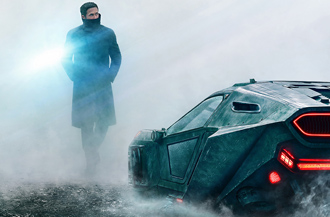|
|
Movie Review: Blade Runner 2049By Matthew HuntleyOctober 19, 2017
On one level, “Blade Runner 2049” is a tried and true science fiction action movie, complete with flying space vehicles, futuristic technology, chase sequences, shoot-outs, etc., all set amidst vast cityscapes with brooding skyscrapers and giant, interactive video monitors, as well as barren, desertic wastelands with sand dunes and heavy winds. These are classic characteristics of the genre, and if you've seen the original “Blade Runner,” or any dystopian science fiction movie, then you know what I mean. But this is just one of the movie's levels, and as a traditional sci-fi adventure, it's nothing short of exemplary, and one of the reasons must be because director Denis Villeneuve allows us time to simply look at and appreciate this rich, intoxicating universe—for its immensity, its beauty, its decrepitude, its sounds, its serenity. “Blade Runner 2049” continues its predecessor's distinct atmosphere and mood and doesn't allow either of them to fall by the wayside or even become secondary. Villeneuve is keenly aware of just how much the cinema can affect our senses, and this film's sights and sounds infect and hypnotize us. Of course, any movie with a near $200 million price tag ought to look and sound top-notch, but even so, the production design, sound design, cinematography and visual effects teams have really harnessed their resources and we marvel in their craftsmanship. Still, the film's visual and audio achievements might have only added up to a technical exercise if it weren't also for the emotional story and performances behind them. On this level, the film penetrates our hearts and minds in such a way that we end up examining our own humanity, our own memories, our own sense of reality. It asks us to consider what we're willing to sacrifice for the people we love and the causes we believe in and reaffirms it's both what we do and what remember that make us who we are. These ideas are written into Hampton Fancher and Michael Green's screenplay and realized through the actors, specifically Ryan Gosling, an actor who has the unique ability to be both strong and threatening yet vulnerable and sensitive. Roles like these remind us of his range. I've a feeling there will be many admirers of “Blade Runner 2049” and for many different reasons. For die-hard fans of Scott's “Blade Runner” (Scott fills in as executive producer this time), they'll appreciate that it remains loyal to that film's vision and message. For me, though, it's the way the film was able to go beyond merely continuing something and instead serve as an unrestrained, expansive experience, one that engages us on multiple levels—viscerally, intellectually, emotionally. It envelops us and causes us to look inside ourselves so that we might remember and reexamine who we are. Not many films have that kind of power.
|

|
|
|

|
Thursday, October 31, 2024
© 2024 Box Office Prophets, a division of One Of Us, Inc.


